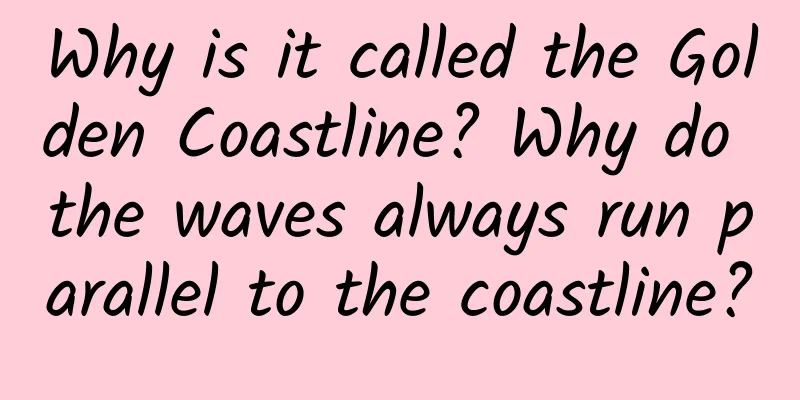Why is it called the Golden Coastline? Why do the waves always run parallel to the coastline?

|
The coastline is one of the most fascinating geographical features on Earth. So far, there is no recognized accurate method to measure the length of the coastline. The length of the coastline is like a fractal. Different measurement intervals (the smallest distance between two points when measuring the length of the coastline) lead to different measurement results. Do you want to know more about the coastline? Just read the following article. Contents of this article 1. Why is it called the Golden Coastline? 2. Why do ocean waves always run parallel to the coastline? 3. What are the advantages of having a long coastline? 1Why is it called the Golden Coastline?The original meaning of the Gold Coast refers to the very rare and precious land adjacent to the edge of the ocean. It is named after the golden beach, which symbolizes wealth and luxury. It is also rich in resources and is often developed into a scenic spot, sightseeing, leisure and vacation tourist destination. When the sun sets, the beach of the Gold Coast is like being sprinkled with gold powder. In the afterglow of the sunset, groups of seagulls fly eagerly to snatch the food abandoned by people. The sea water still washes the beach wave by wave. In the distance of the vast Pacific Ocean, the dusk connects the sea and the sky into a gray. Late at night, after the hustle and bustle, the coastal beach seems particularly quiet. Only the moonlight coming out from the gaps in the clouds shines on the still warm sea water, which is still swaying gently, spitting white foam on the beach wave after wave. In the sun, the Gold Coast is full of golden light. After nightfall, only the sea breeze blows up the waves and sways the shadows of the trees, which is full of poetic and picturesque feelings. 2Why do ocean waves always run parallel to the coastline?If you look closely at a point, you will find that the water surface rises high and then falls low, oscillating repeatedly. The high part is called the "wave crest", and the low part is called the "wave trough". The horizontal distance between two adjacent wave crests or two adjacent wave troughs is called the "wavelength". If you use a stopwatch to observe, you will find that the time interval between two wave crests at a certain point is almost equal, and this time interval is called the "period". That is to say, the period of a wave is the time required for a fixed point to move from one crest (or trough) to the next crest (or trough). The speed at which the crest or trough moves forward is called the wave speed. There are wind waves and swell waves. The waves that are neatly transmitted to the coast in rows are swell waves coming from afar. Its wavelength is longer and the wave speed is faster, which can be hundreds of meters or even thousands of meters, and more than ten meters or even dozens of meters per second. When this long-wavelength swell reaches the shallow sea near the coast, the wave speed will be affected by the seabed topography due to the shallow terrain. The shallower the water, the stronger the friction and the slower the wave speed. In the shallow sea near the coast, the seabed topography is generally always closer to the shore, the shallower the water; and the isobaths are mostly parallel to the coastline. In this way, no matter where the swell comes from in the open sea or from which direction, as long as it reaches the shallow sea near the coast, its wave speed will gradually converge at the isobaths parallel to the coastline. Since the wave speed is the same, the waves will always rush to the shore in parallel. 3What are the advantages of having a long coastline?The first one is that a long coastline does not mean a large territorial sea area; it may be long and winding. Advantages: 1. The coastline is long and winding, which easily forms multi-fjord landforms and deep-water ports, and can fully utilize the advantages of the coast to develop marine transportation. 2. Tidal power generation can be developed. The second type has a long but not winding coastline, mainly because it is located in a coastal plain with a small drop and a gentle terrain. Advantages: 1. It can be developed into coastal beaches and mudflats. It can develop tourism and offshore aquaculture. |
<<: National Ear Care Day丨People who love to clean their ears, you need to know these questions
Recommend
Why does the areola become larger and darker during pregnancy?
A mother's body undergoes great changes durin...
Where does women's back pain come from?
Due to the physical and physiological characteris...
Symptoms of Overactive Bladder in Women
I have bladder hyperactivity syndrome. If I treat...
What to do with anorexic girls
Many people will have anorexia in their lives, es...
Can I eat mango before my period?
We all know that women cannot eat cold foods duri...
Milky white leucorrhea, itchy vulva
Leucorrhea is a normal secretion from the female ...
Will cervical erosion affect the couple's sex life?
Although cervical erosion is a common inflammatio...
What is malignant uterine cyst?
When women suffer from uterine cysts, they must s...
What should I do if my menstruation doesn’t stop after giving birth?
Almost all women have experienced irregular menst...
Why do legs hurt after an abortion?
Whether a woman has a natural miscarriage or an a...
Is it a boy or a girl if estrogen is high during pregnancy
Is it a boy or a girl if estrogen levels are high...
Healthy Life from Oil | What are the effects of excessive intake of edible oil on health?
Excessive intake of edible oil can lead to obesit...
How many days does it take from intercourse to pregnancy
My female compatriots all want to increase the pr...
What are the signs of miscarriage in six months of pregnancy?
Six months of pregnancy is the middle stage of pr...
Why is it "limit salt" instead of "quit salt"?
Author: Cui Yihui, registered dietitian Reviewer:...









